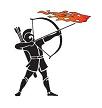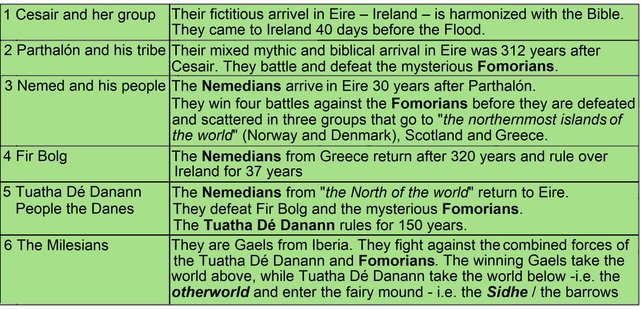
Odysseus
Isse from the island Od in Denmark
Lebor Gabála Érenn
The book of the taking of Ireland
The Book of the Taking of Ireland – Also called The Book of Invasions
The Book of Invasions is a collection of myths on prose from the 13th century which is believed to tell the history of Ireland since the flood.
The Book of Invasions recounts that the Nemedians are battling the Fomorians and lose. They are expelled from Ireland and go to ‘Britain’, to ‘Greece’, and some go ‘to the northernmost islands' – that’s Denmark.
Fir Bolg come back from ' Greece ' and retakes the island of Eire.
37 years later the Tuatha Dé Danann enter the island. They defeat first Fir Bolg and later the Fomorians.
All these events take place likely around 1230 BC, but not on Eire.
It's all a reflection of the Danaans war against Troy as described in the Iliad.
According to the Book of Invasions the first and the second immigration into the island Éire – Ireland – take place after the flood. Two mythical stories.
The third conquest of Eire (Ireland) was done by the Nemedians.
The fourth conquest was carried out by the people the Fir Bolg. It is a historical immigration from Builg or Belgae that probably is the area east of the Rhine in the present-day Netherlands and Belgium.
The fifth conquest of Eire was carried out by ' the goddess Danas people' Tuatha De Danann.
.

The Tuatha Dé Danann and the Nemedians are often in conflict with the Fomorians, a seafaring people mentioned in several myths to have made raids into Ireland and settled down there. The Fomorians are descendants from Noah's son Ham.
The Nemedians come either from Scythia on the Black Sea coast, the Caspian Sea or ' Greece' 330 years after the flood. Nemed is son of the Scythian Greek Agnomen, a name that reminds of the Greek legendary king Agamemnon.
The Nemedians are battling the Fomorians and stand against them till the plague takes almost all the Nemedians. From then on the Nemedians are living as serfs or almost slaves under the Fomorians.
The Nemedians are rebelling and under their leader Fergus Lethderg they attack the Fomorians’ strongly fortified rampart with a tower – Conan on the island of Tory. The Nemedians kill the Fomorian king Conan – also spelled Conaind, but loses the battle and all Nemedians except 30 men are going into exile at three places.
One group is traveling to their ancestral country ' Greece ', another group flees to England and the last escapes to the 'Northernmost islands' – to the people Tuatha Dé Danann.
Tuatha means nation in Lithuanian. Tuatha Dé Danann likely means the Danish people.
The Nemedians are likely the Germanic tribes which Julius Caesar calls Nemetians.
The Nemetians are the Germanic tribes that are origin to the Slavic names of Germany as the Russian Nemetsko, Czech Nemecko and Polish Niemcy. In Hungarian Német means 'German' and Németország means 'Germany'. In the Book of Invasions and elsewhere it is mentioned that they come from Scythia on the Black Sea, the Caspian Sea or Greece.
The Nemedians used the name Feni about themselves, and that indicate 'genuine' Irish.
Fir Bolg – who are they really
The Fir Bolg are the source to many place names after just 37 years in power, while Fomorians, Nemedians, Tuatha De Danann – that’s Danes, and Milesians do not provide any place names despite their massive presence and many years as rulers.
The Nemedians are mentioned in the Book of Invasions (Lebor Gabala) having built two fortifications – one in Armagh and one in Antrim. The Nemedians can not have done that because they are a people who lived on the Baltic coast in the old Prussia.
It is rather the Fir Bolg who built fortifications in Armagh and Antrim.
So Fir Bolg is a genuine Celtic people, likely a Celtic people from the East side of the river Rhine in the present-day Netherlands and Belgium.
Fir Bolg is a P–Celtic peoples who later is followed by K–Celtic people. P–Celts have words with the letter P which K–Celts change to F when the latter come to Ireland. Fir Bolg are considered to be a part of the people with the name Erainn – Irishman.
Fomorians attack Nemedians and Tuatha De Danann, but never Fir Bolg, which of course is obvious as the two peoples have never met each other. Fir Bolg were residing in Ireland and the Fomorians were settled south of the Baltic Sea in Pomerania in Northern Germany and in the present Poland (Po Morze).
Fir Bolg and Irish place names
Fir Bolg is the fourth invasion people in Lebor Gabala – The Book of Invasions. They consist of three groups namely Domnan, Galioin and Lagin – and they rule for 37 years. The name Fir Bolg means ‘men from Bolg', and it suggests that they are immigrants from Builg or Belgae. That is likely present-day Belgium.
Ireland has historically been divided into four provinces: Connacht, Leinster, Munster and Ulster. Place names from the Fir Bolg are mostly found in North and West on Éire.
Domnan settles in the Northwest of County Mayo. Their name is found throughout Ireland, for example the Irish name Inber Domnain which is Malahide Bay in County Dublin. Galioin settles in the region Leinster in counties Wicklow, Kildare and Cavan, but they also lived in the area near the County of Mayo.
Lagin gives its name to the province Leinster. They settle in both Leinster and in the province Connacht.
Fomorians and Irish place names.
The Fomorians has not been the source for any place names in Ireland.
Nemedians and Irish place names.
The Nemedians has not given its name to any place name in Ireland. It is mentioned in Lebor Gabala Érenn – The Book of Invasions – that they have built two fortifications – one in Armagh and one in Antrim.
Milesians and Irish place names.
The Milesians has not been the source for any place names in Ireland.
Tuatha De Danann and Irish place names.
Tuatha De Danann is not mentioned for having founded any city or fortification in Ireland.
Fir Bolgs people is the cause for many place names after just 37 years in power, while the Fomorians, the Milesians, the Nemedians and Tuatha De Danann does cause any place name despite their massive presence and many years as rulers.
Fir Bolg is a genuine Celtic people, likely a Celtic people from the East side of the river Rhine in the present-day Netherlands and Belgium.
Fir Bolg is considered being a part of the people with the name Erainn, that is to say Irish.
The Fomorians attack the Nemedians and Tuatha De Danann (The Danes), but never the Fir Bolg, which of course is obvious because the two people have never met each other.
Fir Bolg were residents in Ireland and the Fomorians were settled south of the Baltic Sea in Pomerania in Northern Germany, and Poland in the current landscape Po Morze.
Tuatha De Danann (The Danes) was residing on the Danish Islands and the Nemedians were residing on the island Rügen and Pomerania.